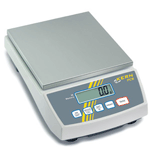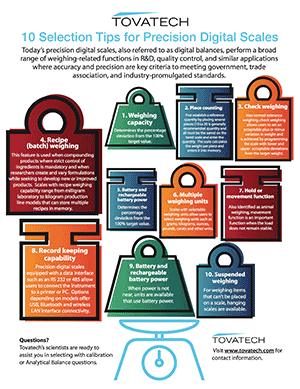
How to Calibrate a Digital Scale
When it comes to explaining how to calibrate a digital scale, here’s a bit of reassurance: Calibrating a digital scale is not that complicated. Because scale calibration is important – required by law in many instances – we offer these instructions on why and how often digital scales should be calibrated.
We’re talking not only precision scales and analytical balances able to weigh in grams and milligrams but also industrial scales weighing in pounds, sales used for recipes, determining percentages, totalizing, counting and other functions used in industry today.
Why you Should Know How to Calibrate a Digital Scale
First of all, as noted above, in many instances it’s required by law. Another source is the National Institute of Standards and Technology’s Weights and Measures Program Requirements, which provides detailed information on this topic.
Why Calibrated Scales are Important
All of us are familiar with transactions where scale accuracy can make a difference. At the deli counter, for example, clerks weigh out your cheese and salami slices on a scale that carries a sticker certifying that it has passed a calibration test on a certain date.
Accurately calibrated digital scales are also critical when weighing in grams, milligrams and smaller samples.
In R&D labs and other demanding applications, for example, calibrating a scale should be conducted on a regular basis as a part of good laboratory practices (GLP). For more information on this please check out our post on compounding pharmaceuticals.
Accurately calibrated digital scales are is also critical in more mundane applications such as weighing and shipping packages and products to insure that both buyer and seller are “getting what they pay for” or “selling what they are paid for.”
This can be expressed in terms of weight or, by the use of counting scales, the number of, for example, nuts or bolts in a box. Take a look at this post describing how counting scales count.
So, now you have an appreciation why it is important to know how to calibrate a digital scale. Now let’s get into
How Digital Scales are Calibrated
When you purchase a scale you may have the option of specifying models that are externally calibrated or internally calibrated.
How to calibrate externally calibrated scales

Externally calibrated scales are most common, running the gamut between certain models in the analytical balance/precision scale categories to platform and heavy-duty industrial models.
In the precision scale categories they are less costly than internally calibrated models with comparable performance parameters.
Externally calibrated scales do, however, require purchasing test weights. Test weights are priced based on weight classes as defined by the International Organization of Legal Metrology. Accuracy classes range from E1 (most accurate) to M3.
The test weight required is based on the maximum weight range for the scale. Test weights should be as close as possible to the scale’s maximum weight; recommended weights are prescribed in user manuals.
For example, the externally calibrated Kern ABS 80-4N offered by Tovatech, with a maximum weighing range of 82 g, should be calibrated with a 50 g test weight.
How to calibrate externally calibrated digital scales is relatively simple. Procedures are spelled out in operations manuals and require only the positioning of the test weight on the weighing plate and selecting calibration on the control panel. The scale will then adjust itself and the exercise is completed.
That means you don’t have to “fiddle with the innards.”
By the way, these test weights also require recalibration as part of ongoing GLP. The frequency of recalibrating test weights depends on the frequency of use, the conditions of use and the your security needs in terms of standards compliance. For more on this see our post discussing calibrating test weights.
How to calibrate internally calibrated analytical balances
In contrast internally calibrated analytical balances use a weight inside the balance and a technician-initiated exercise to accomplish the task.
Balances with automatic internal adjustment are exemplified by the Kern ABJ models allowing weighing accuracy checks at any time simply by pressing the CAL key on the control panel. Automatic recalibration for this model is also initiated
- If there is a temperature fluctuation > 2⁰C
- ~4 hours after the previous recalibration
- When the balance is switched from standby status to weighing mode and condition (1) or (2) has been met.
Procedures are spelled out in the operations manual. Technicians are also given a “2-minute warning” by the balance when an automatic recalibration exercise is about to be performed.
Tips on Purchasing Digital Scales
Now that you know how to calibrate a digital scale, we invite you to learn about what to consider when purchasing one.
Purchasers of scales, whether digital scales and analytical balances or other instruments designed for heavier weighing tasks, draw up selection criteria and compare them to offerings in manufacturers’ catalogs. Here is a brief summary with a focus on precision scales and analytical balances:
- Capacity seems obvious, but not necessarily so. Keep in mind that if you are weighing samples in a container you must take into account the weight of the container, which figures in as the tare weight. As an example, if you are weighing a 100 g sample in a 50 g container your scale should have a capacity of more than 150 g. Taring also applies to weighing pans used to hold small samples.
- Readout, also termed Readability and Resolution, is the smallest difference in weight that can be read and displayed by the unit. For an analytical balance it is typically 0.1 milligram. For bench and platform scales it will vary based on the weighing capacity of the scale.
- Linearity describes the positive or negative deviation of the readout from the actual load on a balance over its weighing range. For example, a 10-gram test weight on the balance should show 10 grams. A 20-gram test weight on the balance should read 20 grams. When both are on the balance it should display 30 grams. But nothing is perfect. High-end analytical balances generally have a linearity of ±0.2 or ±0.3 mg.
- Repeatability is the ability of an analytical balance to display the same result when an object is repeatedly placed on the weighing pan and removed. One would think that this is a given, but not necessarily so when dealing in milligrams. In general the difference between the largest and smallest result is used to specify repeatability.
- Reproducibility is sometimes confused with repeatability but it is different. As one example, will a technician at the West Coast lab get the same result as one at the East Coast lab using the same make and model of analytical scale and following the same procedure? Or, in the same lab will the results be the same if done by different people at different times but on the same scale?
It is critical to know the difference between accuracy and precision. As we explain to our clients an accurate scale is always right in that it shows the correct weight. This is further assured when the scale is calibrated on a regular basis.
Precision means the result is always the same. Unfortunately a scale with excellent precision could also be wrong and therefore precisely inaccurate.
Terms like calibration and linearity are related to accuracy, whereas repeatability and reproducibility are related to precision.
Tips to Protecting Weighing Accuracy
Note: These apply chiefly to precision scales and analytical balances used in labs and similar locations.
Plan in advance where the instrument should be located with the objective of keeping it there “permanently.” Or at least as long as possible. Once it is positioned and calibrated for that location a relocation calls for a recalibration.
Why, you may ask, is this important? It’s because the effect of gravity varies by location.
Avoid Vibrations
Avoid areas subjected to heavy traffic or other sources of vibrations and oscillations that can throw measurements off. If your lab countertop does not provide a stable work surface consider a weighing table with a heavy work surface such as granite and vibration-absorbing rubber components.
Environmental Factors
Drafts and temperature fluctuations are guaranteed routes to inaccurate weighing. Analytical balances are shipped with easily opened and closed clear plastic enclosures to protect the weighing plate from even the slightest draft that can throw off measurements.
Believe it or not, the movement of the technician’s hand can create a slight variation that could affect weighing results. Specimen weighing should be conducted with the doors closed.
Likewise, ambient temperature fluctuations must be avoided. When scouting the location for your analytical balance avoid areas subjected to direct sunlight or proximity to HVAC vents.
Other Tips to Protect Digital Scale Weighing Accuracy
Let the equipment warm up
Analytical balances also should be given time to “warm up” before beginning weighing exercises. On initial commissioning analytical balances may require a number of hours for this.
Technicians have the option of shutting analytical balances down in a stand-by mode to avoid subsequent warm-ups or, if the unit is completely shut off or moved, a longer warm-up time may be required. Details are provided in instruction manuals.
Sample size
Once a sample has been placed on a tared weighing pan in the analytical balance it should not be varied.
Changing the sample size is called dynamic weighing, otherwise described as adding or removing a quantity of the sample. This can result in displaying an incorrect measurement.
Instead remove the sample from the analytical balance and, with a fresh tared weighing pan, add an alternate sample.
Do not exceed the unit’s maximum weighing range.
Stabilization
Stabilization relates to the time that should be allowed between placing a sample on the balance and taking the reading. Data are provided in the manual. The Kern ABS and ABJ series specify a 3-second stabilization.
Good housekeeping
Samples should not remain on the weighing plate. Procedures for regularly cleaning the instrument including immediate removal of spilled samples are detailed in housekeeping procedures contained in user manuals.
Tovatech not only offers a broad range of precision scales, analytical balances and scales for heavier weighting tasks but also provides you with useful selection tips for these instruments and the importance of calibration on a regular basis. For help in selecting an analytical balance best suited to your operations and for further discussions on scale calibration and operation contact the scientists at Tovatech.

